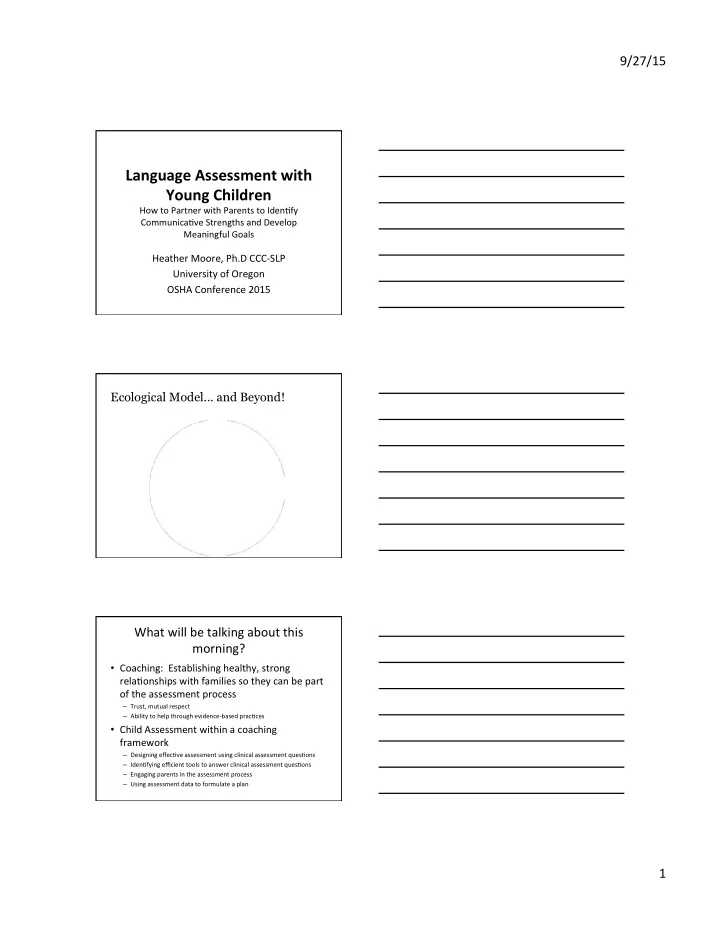

9/27/15 ¡ Language ¡Assessment ¡with ¡ Young ¡Children ¡ How ¡to ¡Partner ¡with ¡Parents ¡to ¡Iden6fy ¡ Communica6ve ¡Strengths ¡and ¡Develop ¡ Meaningful ¡Goals ¡ ¡ Heather ¡Moore, ¡Ph.D ¡CCC-‑SLP ¡ University ¡of ¡Oregon ¡ OSHA ¡Conference ¡2015 ¡ Ecological Model... and Beyond! What ¡will ¡be ¡talking ¡about ¡this ¡ morning? ¡ • Coaching: ¡ ¡Establishing ¡healthy, ¡strong ¡ rela6onships ¡with ¡families ¡so ¡they ¡can ¡be ¡part ¡ of ¡the ¡assessment ¡process ¡ – Trust, ¡mutual ¡respect ¡ – Ability ¡to ¡help ¡through ¡evidence-‑based ¡prac6ces ¡ • Child ¡Assessment ¡within ¡a ¡coaching ¡ framework ¡ – Designing ¡effec6ve ¡assessment ¡using ¡clinical ¡assessment ¡ques6ons ¡ – Iden6fying ¡efficient ¡tools ¡to ¡answer ¡clinical ¡assessment ¡ques6ons ¡ – Engaging ¡parents ¡in ¡the ¡assessment ¡process ¡ – Using ¡assessment ¡data ¡to ¡formulate ¡a ¡plan ¡ 1 ¡
9/27/15 ¡ Session ¡Agenda ¡ • 8:45am-‑ ¡10:00am ¡ ¡ Introduc6on ¡to ¡the ¡ coaching ¡model, ¡Preparing ¡for ¡the ¡assessment ¡ by ¡asking ¡clinical ¡ques6ons ¡ ¡ • 10:00-‑10:15am ¡ Break ¡ • 10:15-‑11:45am ¡ ¡ Methods ¡of ¡assessment, ¡ planning ¡for ¡interven6on ¡and ¡seXng ¡goals ¡ Have ¡you ¡been ¡in ¡a ¡coaching ¡rela6onship? ¡ What ¡was ¡important ¡about ¡that ¡rela6onship ¡(elements)? ¡ COACHING ¡ Coaching ¡ ¡ • A ¡voluntary, ¡nonjudgmental, ¡collabora6ve ¡ partnership ¡between ¡2 ¡or ¡more ¡people ¡ • Essen6al ¡Elements ¡ – Collabora6on ¡ – Reflec6on ¡ – Reciprocity ¡ – Based ¡on ¡Performance ¡ – Driven ¡by ¡Context ¡ 2 ¡
9/27/15 ¡ Coaching ¡In ¡EI ¡SeXngs ¡ Coach ¡ Adult ¡Being ¡ Coached ¡ SeXngs ¡and ¡ Contexts ¡ Child ¡ Evidence-‑Based ¡Family ¡Coaching ¡ Prac6ces ¡in ¡EI ¡ • Individual ¡approach ¡to ¡family ¡coaching ¡ • Focus ¡on ¡daily ¡rou6nes ¡with ¡the ¡family’s ¡materials ¡in ¡natural ¡ seXngs ¡ • Focus ¡on ¡suppor6ng ¡family ¡par6cipa6on ¡and ¡building ¡family ¡ capacity ¡and ¡competence ¡ • Works ¡directly ¡with ¡the ¡caregiver ¡and ¡uses ¡effec6ve ¡coaching ¡ strategies ¡ • Focus ¡on ¡caregiver ¡responsivity ¡and ¡caregiver-‑child ¡interac6ons ¡ • Use ¡of ¡videos ¡for ¡demonstra6on ¡and ¡reflec6on ¡ • Iden6fy ¡opportuni6es ¡to ¡prac6ce ¡across ¡the ¡day ¡and ¡in ¡between ¡ visits ¡ • Systema6c ¡progress ¡monitoring ¡ EI ¡Coaching ¡Resources ¡ • Campbell, ¡P.H., ¡& ¡Sawyer, ¡L.B. ¡(2007). ¡ ¡ Suppor6ng ¡learning ¡opportuni6es ¡in ¡natural ¡ seXngs ¡through ¡par6cipa6on-‑based ¡services. ¡ ¡ Journal ¡of ¡Early ¡Interven0on, ¡29, ¡287-‑305. ¡ • Moore, ¡H.W., ¡Barton, ¡E.B., ¡& ¡Chironis, ¡M. ¡(2014). ¡ ¡ A ¡program ¡for ¡improving ¡toddler ¡communica6on ¡ through ¡parent ¡coaching. ¡ ¡ Topics ¡in ¡Early ¡ Childhood ¡Special ¡Educa0on, ¡33, ¡ 212-‑224. ¡ • Rush, ¡D.D., ¡& ¡Shelden, ¡M.L. ¡(2011). ¡ ¡ The ¡early ¡ childhood ¡coaching ¡handbook. ¡ ¡Bal6more, ¡MD: ¡ ¡ Paul ¡H. ¡Brooks ¡Publishing. ¡ 3 ¡
9/27/15 ¡ Coaching ¡Process ¡ Prepare ¡ Formulate ¡a ¡ Session ¡Plan ¡ Gain ¡Entry ¡ Build ¡ RelaEonships ¡ Evaluate ¡ Implement ¡ Gather ¡ InformaEon ¡ Formulate ¡an ¡ Reflect ¡ IntervenEon ¡Plan ¡ Prepare ¡ Ask ¡Clinical ¡Assessment ¡Ques6ons ¡ • What ¡are ¡clinical ¡assessment ¡ques6ons? ¡ • Ques6ons ¡about: ¡ o Child ¡ • Current ¡skills? ¡ • Skills ¡to ¡target ¡in ¡therapy? ¡ o Caregiver ¡ • Current ¡ability ¡to ¡s6mulate ¡communica6on? ¡ • Needs? ¡ o The ¡best ¡interven6on ¡approach? ¡ o Current ¡supports ¡and ¡services? ¡ ¡ Clinical ¡QuesEons ¡Vary ¡by ¡Stage ¡of ¡IntenEonal ¡ CommunicaEon ¡ PrelinguisEc ¡Development ¡ Emergent ¡Language ¡ Perlocu6onary ¡ Illocu6onary ¡ Locu6onary ¡ Stage ¡ Stage ¡ Stage ¡ 0-‑8 ¡months ¡ 8-‑12 ¡months ¡ 12 ¡months ¡ Paul, ¡R. ¡& ¡Norbury ¡(2011). ¡ ¡Language ¡Disorders ¡from ¡Infancy ¡through ¡Adolescence: ¡ ¡Listening, ¡ Speaking, ¡Reading, ¡Wri6ng, ¡and ¡Communica6ng. ¡ ¡Elsevier ¡Publishing ¡St. ¡Louis, ¡MI. ¡ 4 ¡
9/27/15 ¡ Perlocu6onary ¡Clinical ¡Assessment ¡ Ques6ons ¡ ¡ ¡ QuesEons ¡about ¡the ¡Child ¡ • Time ¡in ¡and ¡transi6on ¡through ¡behavioral ¡ states? ¡ – Sleep ¡States ¡(deep, ¡light, ¡drowsy) ¡ – Alert ¡States ¡(quiet, ¡ac6ve) ¡ – Crying ¡(fussy, ¡ac6ve) ¡ • Par6cipa6on ¡in ¡Early ¡Communica6ve ¡ Interac6ons ¡(protoconversa6ons)? ¡ – Mutual ¡Agen6on ¡ ¡ ¡ – Joint ¡Agen6on ¡ Perlocu6onary ¡Clinical ¡Assessment ¡ Ques6ons ¡ ¡ QuesEons ¡about ¡the ¡Child ¡ • Sound ¡development? ¡(rate, ¡type ¡and ¡varia6on ¡ of ¡sounds) ¡ • Related ¡factors? ¡ Perlocu6onary ¡Clinical ¡Assessment ¡ Ques6ons ¡ ¡ QuesEons ¡about ¡the ¡Caregivers ¡ • Caregivers ¡ability ¡to ¡help ¡the ¡infant/child ¡balance: ¡ – Self-‑regula6on? ¡ – Social ¡interac6on? ¡ • Caregiver ¡ability ¡to ¡par6cipate ¡in ¡protoconversa6ons? ¡ – Responsivity ¡and ¡language ¡s6mula6on ¡ – Enjoyment/ ¡Acceptance ¡ – Reciprocity ¡and ¡mutuality ¡ – Encouragement ¡of ¡joint ¡agen6on ¡ • Caregiver’s ¡ability ¡to ¡use ¡AAC? ¡ ¡ 5 ¡
9/27/15 ¡ Perlocu6onary ¡Clinical ¡Assessment ¡ Ques6ons ¡ ¡ QuesEons ¡about ¡IntervenEon ¡approach ¡ • Possible ¡Approaches ¡ – Social ¡interac6on ¡approaches ¡ – Picture ¡Exchange ¡Communica6on ¡System ¡(PECS)? ¡ • Who ¡will ¡implement ¡the ¡approach? ¡ – Parent/ ¡Rela6ve/ ¡Care ¡provider? ¡ – Role ¡of ¡the ¡Clinician? ¡ Perlocutionary: Clinical Assessment Questions ¡ Does ¡this ¡child ¡spend ¡an ¡appropriate ¡amount ¡of ¡6me ¡in ¡an ¡awake, ¡calm, ¡and ¡alert ¡ state? ¡ ¡Can ¡the ¡child ¡be ¡calmed ¡easily ¡when ¡upset? ¡ Does ¡the ¡child ¡enjoy ¡interacEng ¡with ¡adults? ¡ ¡Does ¡he/she ¡display ¡mutual ¡and/or ¡ joint ¡aUenEon? ¡ What ¡sounds ¡does ¡the ¡child ¡make? ¡ ¡How ¡frequently ¡does ¡the ¡child ¡vocalize? ¡ ¡ Is ¡the ¡caregiver ¡responsive ¡to ¡the ¡child’s ¡needs ¡and ¡communicaEon ¡aUempts? ¡ ¡ Does ¡she/he ¡display ¡turn-‑taking ¡during ¡protoconversaEons? ¡ ¡Does ¡he/she ¡ encourage ¡joint ¡aUenEon? ¡ ¡Does ¡she/he ¡encourage ¡new ¡sounds? ¡ Does ¡the ¡parent ¡appear ¡to ¡enjoy ¡interac6ng ¡with ¡their ¡child? ¡ ¡Do ¡they ¡seem ¡to ¡read ¡ their ¡signals ¡and ¡know ¡how ¡to ¡sooth ¡the ¡child? ¡ ¡Do ¡they ¡appear ¡overly ¡anxious ¡or ¡ depressed? ¡ What ¡would ¡be ¡a ¡good ¡interven6on ¡approach? ¡ ¡PECS? ¡ Clinical ¡QuesEons ¡Vary ¡by ¡Stage ¡of ¡IntenEonal ¡ CommunicaEon ¡ PrelinguisEc ¡Development ¡ Emergent ¡Language ¡ Perlocu6onary ¡ Illocu6onary ¡ Locu6onary ¡ Stage ¡ Stage ¡ Stage ¡ 0-‑8 ¡months ¡ 8-‑12 ¡months ¡ 12 ¡months ¡ 6 ¡
Recommend
More recommend